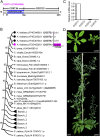COST1 regulates autophagy to control plant drought tolerance
- PMID: 32170020
- PMCID: PMC7132278
- DOI: 10.1073/pnas.1918539117
COST1 regulates autophagy to control plant drought tolerance
Abstract
Plants balance their competing requirements for growth and stress tolerance via a sophisticated regulatory circuitry that controls responses to the external environments. We have identified a plant-specific gene, COST1 (constitutively stressed 1), that is required for normal plant growth but negatively regulates drought resistance by influencing the autophagy pathway. An Arabidopsis thaliana cost1 mutant has decreased growth and increased drought tolerance, together with constitutive autophagy and increased expression of drought-response genes, while overexpression of COST1 confers drought hypersensitivity and reduced autophagy. The COST1 protein is degraded upon plant dehydration, and this degradation is reduced upon treatment with inhibitors of the 26S proteasome or autophagy pathways. The drought resistance of a cost1 mutant is dependent on an active autophagy pathway, but independent of other known drought signaling pathways, indicating that COST1 acts through regulation of autophagy. In addition, COST1 colocalizes to autophagosomes with the autophagosome marker ATG8e and the autophagy adaptor NBR1, and affects the level of ATG8e protein through physical interaction with ATG8e, indicating a pivotal role in direct regulation of autophagy. We propose a model in which COST1 represses autophagy under optimal conditions, thus allowing plant growth. Under drought, COST1 is degraded, enabling activation of autophagy and suppression of growth to enhance drought tolerance. Our research places COST1 as an important regulator controlling the balance between growth and stress responses via the direct regulation of autophagy.
Keywords: Arabidopsis; COST1; autophagy; drought.
Conflict of interest statement
The authors declare no competing interest.
Figures






Comment in
-
COST1 balances plant growth and stress tolerance via attenuation of autophagy.Autophagy. 2020 Jun;16(6):1157-1158. doi: 10.1080/15548627.2020.1752981. Epub 2020 Apr 14. Autophagy. 2020. PMID: 32268813 Free PMC article.
References
-
- Pennisi E., Plant genetics. The blue revolution, drop by drop, gene by gene. Science 320, 171–173 (2008). - PubMed
-
- Mittler R., Blumwald E., Genetic engineering for modern agriculture: Challenges and perspectives. Annu. Rev. Plant Biol. 61, 443–462 (2010). - PubMed
-
- Yamaguchi-Shinozaki K., Shinozaki K., Transcriptional regulatory networks in cellular responses and tolerance to dehydration and cold stresses. Annu. Rev. Plant Biol. 57, 781–803 (2006). - PubMed
Publication types
MeSH terms
Substances
LinkOut - more resources
Full Text Sources
Other Literature Sources
Molecular Biology Databases

